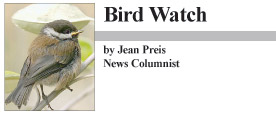Good Neighbors
 There has been a confusion of the seasons lately: a big snowstorm bracketed by very warm days. The day after the storm, with a foot of snow on the ground, I paddled my kayak on the lake. Afterward, I came ashore and put my paddle away, got out the ice chopper, and chopped ice in the driveway. In spite of this temporary confusion, we know winter is approaching because early some mornings we see columns of mist rising off the water, creating a stately procession of tall white shapes that move wraith-like up the lake. The tall shapes sway gracefully as if speaking with one other, and the tallest occasionally bend down slightly toward the smaller ones. Silhouetted against the dark background of the trees on the opposite shore, it would be easy to believe they are lake spirits out for a dawn stroll, parading regally up the boulevard of their watery domain.
There has been a confusion of the seasons lately: a big snowstorm bracketed by very warm days. The day after the storm, with a foot of snow on the ground, I paddled my kayak on the lake. Afterward, I came ashore and put my paddle away, got out the ice chopper, and chopped ice in the driveway. In spite of this temporary confusion, we know winter is approaching because early some mornings we see columns of mist rising off the water, creating a stately procession of tall white shapes that move wraith-like up the lake. The tall shapes sway gracefully as if speaking with one other, and the tallest occasionally bend down slightly toward the smaller ones. Silhouetted against the dark background of the trees on the opposite shore, it would be easy to believe they are lake spirits out for a dawn stroll, parading regally up the boulevard of their watery domain.
The birds have not yet come to the feeders this morning, and I am hoping that the chickadees, nuthatches and woodpeckers who normally breakfast here are tucked snugly into their featherbeds. By this time of the year, these birds should have found hollow cavities inside trees where they can roost on cold nights, crowding together to conserve body heat and keep from freezing. More than 20 species of birds in our area use natural cavities in trees for nesting and for winter roosting. Woodpeckers are the primary cavity nesters and excavators. Their strong bills and neck muscles are specially designed for opening up cavities in hard wood, both for their nests and to dig out insects. Other species, such as chickadees, nuthatches, brown creepers, and some owls, are secondary cavity nesters. They lack the equipment necessary for creating holes in trees, and even though they can improve or enlarge existing cavities they are dependent on woodpeckers, and on natural decay, to do the initial work.
Most cavity nesting birds are insect eaters. They feed on insect eggs, larvae, and pupae year round, retarding the growth of local insect populations and preventing epidemics of insects from developing. When woodpeckers flake off the bark, or puncture and drill into trees in search of insects, they alter the habitat of the insects who live in and on the trees, exposing them to the drying sun and wind, as well as to freezing and to danger from other predators. Research on woodpeckers and their feeding methods has found that they control insect populations as much by this indirect damage as by eating the insects.
With the arrival of winter, many of those birds will need to find cavities in old trees where they can find shelter from the weather. All the birds who nest in tree cavities in spring, and roost in them in winter, are extremely beneficial to our forest, but these good neighbors would not be able to survive around here without an adequate supply of suitable trees in the forest for them to use. Woodpeckers, chickadees, nuthatches, brown creepers, and owls can live only in forests that contain trees of different ages. In our neighborhood we are fortunate to still have enough old trees to support a population of cavity-nesting and cavity-roosting birds.
Perhaps the tall wraiths moving serenely up the lake in the early mornings are the lake spirits, but they might also be the spirits of old trees that long ago sheltered growing young families of birds, and kept them warm on cold nights.
• The Christmas Bird Count will be held Dec. 28, 2011. To learn how to participate, phone 647-2847. We especially need Feeder Counters — folks who live within the 15-mile circle, who watch from the comfort of home, and who are able to identify the most common birds at their feeders.

